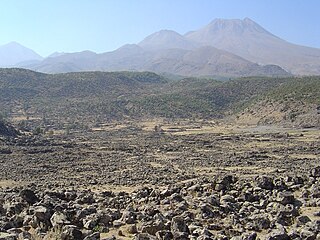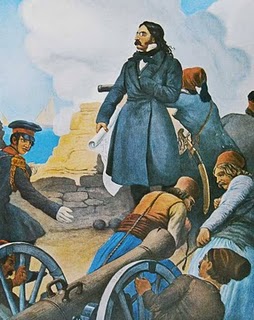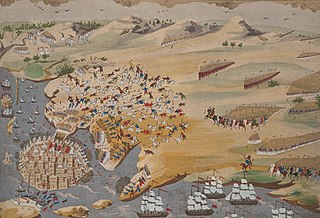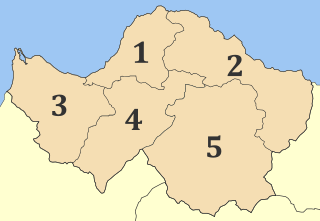
Greek National Road 5 is a single carriageway road in western Greece. It connects Antirrio, at the north end of the Rio-Antirrio bridge, with Ioannina in northwestern Greece, passing through Agrinio and Arta. The southern part, between Amfilochia and Antirrio, is part of the European route E55. The northern part, between Ioannina and Amfilochia, forms the European route E951. It passes on the east side of the Ambracian Gulf. In the future much of the traffic that used this road will be diverted to the new A5 motorway, which has already taken over parts of the road.

United Airlines Flight 297, a Vickers Viscount 745D, was a scheduled flight from Newark International Airport (EWR/KEWR) in Newark, New Jersey to Washington, D.C. with 17 people on board.
Tripolis, formerly Ischopolis, was an ancient fortress city in Pontus Polemoniacus, on a river of the same name, and with a tolerably good harbor; it is now the site and namesake of the city of Tirebolu in Giresun Province, Turkey. It belonged to the Mossynoeci and was situated at a distance of 18 km east from Cape Zephyrium. The place is situated on a rocky headland.

Mokissos is the formal name for a now inactive Diocese of the Greek Orthodox Church.
Oinochori is a small village in the municipal unit of Gravia, Phocis, Greece. It is located at an altitude of approximately 900 meters on the slope of Mount Oiti. Ruins just outside the village are thought to be from the Dorian or pre-Dorian city of Dryopis.

The First Siege of Missolonghi was an attempt by Ottoman forces to capture the strategically located port town of Missolonghi during the early stages of the Greek War of Independence.
Drosia is a neighbourhood in the city of Patras, Greece, 3 km east-southeast of downtown.
Begoulaki is a neighbourhood in the city of Patras. The name is originally derived from Bey Ulak, a Turkish landlord who lived in the area during the Ottoman period. Today, the usual form of the name is "Myloi" (Μύλοι) even though other people kept the toponym Begoulaki. The current neighborhood was named "Myloi" before the Ottoman era, but the Byzantine chronographer G. Frantzis referred to it as "Mylous". The area was made into a military base by Constantine XI Paleologus during his siege of Patras as the despot of Mystra. It was also the place where Constantine married his first wife. Shortly after the Greek Revolution, the area had a lot of mills to which it received its name. The Roufos family lived in the area, as well as members from the Kollas clan.
Riganokampos is a neighbourhood in the eastern part of the city of Patras by the foot of the Panachaiko mountains.

Skioessa is a neighbourhood and a settlement in the northeastern part of the city of Patras. Skioessa had a population of 526 for the settlement. Skioessa is located 5 km from downtown Patras, about 5 km southeast of Rio, about 37 km west of Aigio and 2 km east of the GR-8/E55 (Athens - Corinth - Patras and Aretha Street. The previous name of this suburb, Voudeni, is still in use.
Zarouchleika or Zarouchlaiika, official name Glafkos, is a residential neighbourhood in the southern part of the city of Patras, Greece. It is about 3 km south from the city centre. The main streets of Zarouchleika are the coastal road Akti Dymaion and Antheias Street. The OSE's railway from Patras to Pyrgos passes west of Zarouchleika.
Agia Sofia is a neighbourhood that lies directly north of the centre of Patras, Greece city. It takes its name from the Agia Sofia church, which is the main church of the neighbourhood. At the centre of the neighbourhood is Nikis Square, at the intersection of Agias Sofias Street and Konstantinoupoleos Street. Agia Sofia lies near the sea side. Several important roads, including Greek National Road 8, pass through Agia Sofia. The Piraeus–Patras railway passes through the western part.
Aroi is a neighbourhood in the city of Patras, Achaea, Greece. It is built in a hilly area near the ancient acropolis, which is known as the Castle of Aroi.

Asyrmatos is a neighbourhood in the city of Patras, Achaea, Greece.
Dasylio is a neighbourhood in the city of Patras, Achaea, Greece.
Girokomeio is a neighbourhood in the city of Patras, Achaea, Greece.

Patras Province was a province covering the western part of the Achaea prefecture, Greece. Its largest city and seat of administration was Patras. Its territory corresponded with that of the current municipalities Patras, Erymanthos and West Achaea, and the municipal unit Erineos. It was abolished in 2006.

The Second Siege of Missolonghi was a second attempt by Ottoman forces to capture the strategically located port town of Missolonghi during the third year of the Greek War of Independence (1823). The second siege is usually ignored however, and the name is often applied to the greater siege of 1825–1826.

The Siege of Patras was one of the first events of the Greek War of Independence (1821-1830). After the outbreak of the revolution, the Greeks of Patras tried to capture the main fortress of the city. After a long period and several sieges, finally the Ottomans restored the order and Patras remained under Ottoman control almost until the end of the war.
Apollonis , also known as Apollonia (Ἀπολλωνία), Apollones (Ἀπολλώνης), and Apollonias (Ἀπολλωνίας), was a city in ancient Lydia. It was located south of Apollonia in Mysia, where there is a ridge of hills, after crossing which the road to Sardis had on the left Thyatira, and on the right Apollonis, which was 300 stadia from Pergamum, and the same distance from Sardis. It was named after the queen Apollonis, the mother of Eumenes II and Attalus II of Pergamum, in the place of an older city; possibly Doidye. It was mentioned by Cicero. It was destroyed in 17 CE by the great earthquake that destroyed twelve cities of Asia Minor. Tiberius rebuilt the city. It issued coins; those from Marcus Aurelius to Severus Alexander are extant. Apollonis is a titular see of the Roman Catholic Church.













